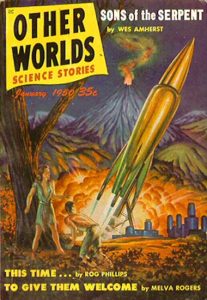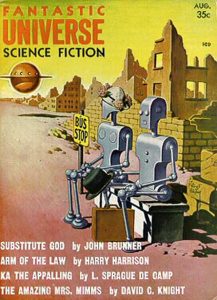2 “There Will Come Soft Rains”
davinaramirez
“There Will Come Soft Rains” is a short story written by the great American science-fiction author Ray Bradbury. It was first published in 1950 and appears in the book The Martian Chronicles.
Learning Objectives:
- Understand a Poem
- Activate Background Knowledge
- Read in “Chunks”
- Learn Cultural Context
- Vocabulary
- Setting, Character & Plot
- Comprehend Story Details
- Identify Figurative Language
- Sentence Exploration
- Deeper Understanding
- Participate in a Lit Circle
Learning Objective 1: A Poem
Read and understand a poem
There Will Come Soft Rains
by Sara Teasdale, 1920
There will come soft rains and the smell of the ground,
And swallows circling with their shimmering sound;
And frogs in the pools singing at night,
And wild plum trees in tremulous white;
Robins will wear their feathery fire,
Whistling their whims on a low fence-wire;
And not one will know of the war, not one
Will care at last when it is done.
Not one would mind, neither bird nor tree,
If mankind perished utterly;
And Spring herself, when she woke at dawn
Would scarcely know that we were gone.
Do you agree with the poem’s prediction?
Learning Objective 2 – Activate Background Knowledge
Answer each of these questions with a short discussion. Use complete sentences.
Before You Read:
1. What are nuclear weapons? Have they been used before? When?

Public Domain. https://commons.wikimedia.org/wiki/File:FEMA_-_2720_-_Photograph_by_FEMA_News_Photo.jpg
2. What are the effects of a nuclear bomb?
3. What was the Cold War? When did it happen? Why did it happen?
4. What modern devices make a “smart” house?
5. Will all houses be “smart houses” in the future?
6. Do you have any “smart home” devices? Do you want to live in a smart home? What are the pros and cons?
Learning Objective 3: Reading in Chunks
Listen to the story to hear the grammar.
Read this part of the story aloud or listen to your instructor read. Answer the questions.
| Story | “Glosses” |
| In the living room the voice-clock sang, tick-tock, seven o’clock, time to get up, time to get up, seven o’clock! as if it were afraid that nobody would. The morning house lay empty. The clock ticked on, repeating and repeating its sounds into the emptiness. Seven-nine, breakfast time, seven-nine! In the kitchen the breakfast stove gave a hissing sigh and ejected from its warm interior eight pieces of perfectly browned toast, eight eggs sunnyside up, sixteen slices of bacon, two coffees, and two cool glasses of milk. “Today is August 4, 2026,” said a second voice from the kitchen ceiling, “in the city of Allendale, California.” It repeated the date three times for memory’s sake. “Today is Mr. Featherstone’s birthday. Today is the anniversary of Tilita’s marriage. Insurance is payable, as are the water, gas, and light bills.” Somewhere in the walls, relays clicked, memory tapes glided under electric eyes. Eight-one, tick-tock, eight-one o’clock, off to school, off to work, run, run, eight-one! But no doors slammed, no carpets took the soft tread of rubber heels. It was raining outside. The weather box on the front door sang quietly: “Rain, rain, go away; rubbers, raincoats for today…” And the rain tapped on the empty house, echoing. |
What is a “voice-clock”?Is it actually afraid?
|
Learning Objective 4: Cultural Context
Learn about the culture Ray Bradbury lived in at the time this story was written.
“There Will Come Soft Rains” was written in 1950. Ray Bradbury, the writer, was one of the original creators of the science fiction genre.
The US in 1950
The 1940’s and 1950’s – after WWII – were a period of incredible technological change. Many everyday objects for us – cars, phones, computers – were available to common people for the first time ever, and that changed American culture. Everyday people were more comfortable than ever before.
Most countries at this time could be divided into two groups: the capitalist and democratic group, which included the US and Western Europe, and the Communist group, which included Russia. At this time Russia was called the USSR.
Learn more about post-war America here:
https://www.history.com/news/post-world-war-ii-boom-economy
The Cold War
But these technological advances had a dark side. These technologies were also used for war. The US and the Soviet Union were enemies; both sides raced to create more powerful weapons, rockets, satellites, computers, bombs. People in both countries lived in non-stop fear of the other side. This competition was called the “Cold War.” It affected the US by creating a feeling of distrust and fear. Americans were suspicious and sometimes accused each other of being “Communists.” The Cold War went on until the 1980s, and it affected many countries.
Learn more about the Cold War here:
https://simple.wikipedia.org/wiki/Cold_War
Learn about the Space Race here:
https://simple.wikipedia.org/wiki/Space_Race
Was your home country also affected by the Cold War? Brainstorm a few facts you know about the U.S. and your home country at that time.
Science Fiction

Public Domain. https://commons.wikimedia.org/wiki/File:Other_worlds_science_stories_195001.jpg
Because of the fast technological development, humans suddenly were thinking about the possibility of entering outer space and traveling to the moon, to other planets, even to the stars. This changed the imagination of everyday people. A new kind of writing developed: science fiction. This was fiction that told stories that were only possible with technology that was different from the world of that time. Many stories were about space travel. Other common topics were robots and atomic bombs.
Learn more about science fiction here:
https://simple.wikipedia.org/wiki/Science_fiction
Format
Stories like “August 2026: There Will Come Soft Rains” appeared in magazines like Fantastic Science Fiction. Notice the use of quotation marks and italics. Why is each used?

Public Domain. https://commons.wikimedia.org/wiki/File:Fantastic_universe_195808.jpg
Learning Objective 5: Vocabulary
Practice using vocabulary words from the story.
Vocabulary: Verbs
Vocabulary: Guessing Meaning from Context 1
Vocabulary: Guessing Meaning from Context 2
Read each sentence. Guess the meaning of the underlined words.
Learning Objective 6: Setting, Character & Plot
Define the setting and characters; analyze the plot with a timeline
After You Read: Setting
* * *
Plot
Learning Objective 7: Comprehension
Check your understanding of the story.
1) What are the “mice”?
2) When and where does the story “There Will Come Soft Rains” take place? What has happened to the city?
3) There are five places described in the story. Name each one.
4) Explain this quote: “The house was an altar with ten thousand attendants, big, small, servicing, attending, in choirs. But the gods had gone away, and the ritual of the religion continued senselessly, uselessly.”
5) How long had the dog been outside the house? What has happened to the dog before it enters the house? Why do you think so?
6) What special things happen during “the children’s hour?”
7) Think about this quote: “At ten o’clock the house began to die.” Why does Bradbury use the word “die”?
8) Find an additional quote that Bradbury uses to make the house seem human. Format the quotes correctly.
9) What’s the first way the house tries to put out the fire?
10) What’s the second way the house tries to put out the fire?
11) What does the fire do that is “clever”?
12) Look up the words “oblivious,” “insanely,” “maniac,” “psychopathic” and “hysterically.” What meaning do these words share?
Learning Objective 8: Figurative Language
Understand simile, metaphor and personification
Figurative language is an expressive, emotional way to add description to writing. The writer compares two things creatively. There are two general kinds of figurative language:
- A simile is figurative language that uses “like” or “as.”
- A metaphor is figurative language that does NOT use “like” or “as.”
- There’s a special kind of metaphor called personification: the metaphor describes something non-human by comparing it to a human.
Examples:
- I slept like a log. (S)
- He’s as dumb as a box of rocks. (S)
- They fought like cats and dogs. (S)
- “Built Like A Rock” (Chevrolet ad) (S)
- “Either way … he died like a bug under a microscope.” – Stephen King (S)
- In the garden, eggplants grow curving like ox horns. (S)
- The noise split the air. (M)
- “If you plant ice, you’re going to harvest wind.” – The Grateful Dead (M)
- I’m drowning in work. (M)
- “Baby, you’re a firework.” – Katy Perry (M)
- “Life is a box of chocolates. You never know what you’ll get.” – Forrest Gump (M)
- New York is the city that never sleeps. (M, P)
- “I wandered lonely as a cloud.” – William Wordsworth (M, P)
- Necessity is the mother of invention. (M, P)
- The old hardwood floor groaned under his heavy steps. (M, P)
- The lonely train whistle called out in the night. (M, P)
- The snow wrapped a white blanket around each tree. (M, P)
- “From the kitchen came the coughing of bellows.” – Ha Jin (M, P)
- “Because I could not stop for Death – He kindly stopped for me -” – Dickinson (M, P)
This story has strong personification: the house is compared to a person with emotions (and with psychological problems). Which of these quotes develops that idea?
Learning Objective 9: Sentence Exploration
Each of these quotations describes a situation in the story. The world of the story is very different from our world. Try to explain the entire situation expressed in the quote; why is it like that? What does Bradbury want us to imagine? Use simple language.
Learning Objective 10: Deeper Understanding
Write a complete paragraph to answer each question. Use quotations where you feel they will help you answer fully. If your teacher instructs you, choose several questions and write complete paragraphs to answer.
- Explain why the west face of the house is black. How did the silhouettes get there?
- Who is the main character of this story?
- One adjective that describes the character:__________________________“Prove it!” – Write a quote from the story that supports the adjective
- One different adjective that describes the character’s personality:“Prove it!” – Write a quote from the story that supports the adjective
- Conflict: What is the main conflict of this story?
- Connection: How does this story connect to the poem? How are their main ideas similar – and what is the big difference between them?
Learning Objective 10: Literature Circle
In a literature circle, each member takes a different role (questioner, clarifier, illustrator or extender). After you prepare, you will present your part to the entire “circle.” Each person will speak for 5-10 minutes. You should prepare something to share to the group as you talk: either a handout or a slideshow.
Questioner
Your task is to check your group’s understanding and prepare them for a quiz.
Write five “easy” questions that might be on a quiz for EACH story. These can be “true/false” or “yes/no” type questions; there should be ONE correct answer. These are like Costa’s “Level 1” questions below. Ask your group the questions.
Then, write one or two “discussion” questions for each story. Maybe you should choose an interesting quote and ask “What does this mean?” Maybe you should ask about a character, “Why did they act that way?” These questions could have many “right” answers, because they are more about the opinions of the person answering. These should be like Costa’s “Level 2” or “Level 3” questions. Of course – you must be able to answer all your own questions!
Costa’s Levels of Inquiry
Level One Questions: ComprehensionReaders can point to one correct answer in the text. Words found in these questions include: ✴ define ✴ describe ✴ name, identify ✴ list ✴True/False or Yes / No |
Level 1 Example Questions:Define the word “maniac”. Describe the dog’s appearance. What is on the side of the house? True or false: The street is full of houses that look the same as this house. |
Level Two Questions: InferenceReaders infer answers from what the text implicitly states, finding answers in several places in the text. These questions ask you to: ✴analyze ✴compare ✴contrast ✴put in time order ✴describe character’s motivations and personalities |
Level 2 Example Questions:Would the house be comfortable to live in? Why?
Who does the house care for more: itself or the dog?
|
Level Three Questions: ConnectionsReaders think beyond the text. Answers are based on the reader’s research, knowledge or experience. These questions ask you to: ✴connect ✴imagine ✴ predict ✴ put in context ✴compare to another reading |
Level 3 Example Questions:What happened to the city of Allendale? Who did that? How does this short story reflect the Cold War? Does the house love its family? Why or why not? What will happen on August 6?
|
Clarifier
Your task is to understand and explain key sentences from the story.
Make a list of some of the figurative language in the story: at least four examples. Choose examples that are interesting to you. Share the list with your group. Label each example: simile, metaphor, or metaphor + personification. Be prepared to explain what two things are compared in each example, and don’t forget to use quotation marks around each quote!
Illustrator
Your task is to put key moments from the story into art to help everyone “see” it.
Create a slideshow with pictures that illustrate four or more key moments from the story. You can draw the scenes in any way you like: pencil, pen, paint, or electronically. However, you may NOT simply download images that other people have created. The pictures don’t need to look realistic or “professional,” but they should demonstrate important moments from the story and have details your group can recognize.
Extenders: Bradbury
Make notes using a chart like the one below and explain these connections to your group.
1950s theme from the story: |
History: Why did Americans feel this? |
|
Fear of nuclear war:
|
|
| Excitement about new technology: | |
|
Fear of new technology:
|
Key Takeaways
After finishing this chapter, you should be able to:
- Summarize Sara Teasdale’s poem in one sentence
- Explain the cultural importance of the 1950’s in America, the Cold War, and science fiction to this story
- Recognize some key vocabulary used in the story
- Identify the setting, characters, plot and conflict of the story
- Summarize the story with 5-10 plot points, including what happened before the story begins
- Define figurative language: simile, metaphor and personification
- Recognize and explain examples of figurative language
- Find several quotations that describe the main character

